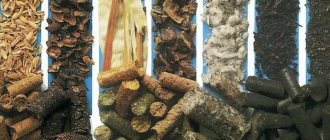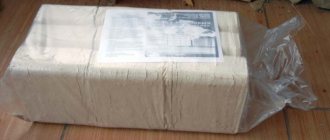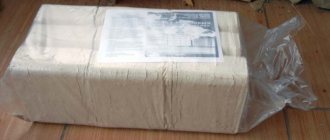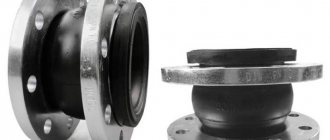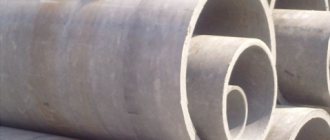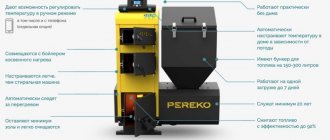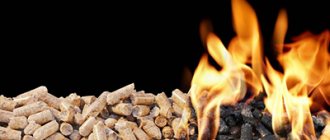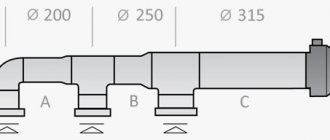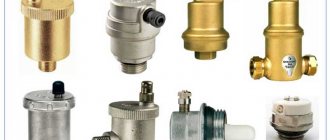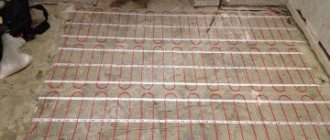Description and properties of fuel briquettes
Fuel briquettes , like firewood, are solid fuels. Externally, the product may resemble thick Cuban cigars, bricks, logs or pieces of laundry soap.
Briquettes can be easily shaped into any shape since they are made from crushed material. This is always secondary raw material, waste from important production. For example, we sawed an inch board. Where to put the sawdust.
They can be packaged in bags and sent to a pet store as bedding for hamsters and guinea pigs. You can add sawdust to the soil for plants, or you can press it into briquettes. As a result, the consumer will receive energy without destroying the entire forest. The price tag of the product is also attractive.
The production of fuel briquettes has gained momentum due to the advantages of the product. It outperforms conventional firewood in the following parameters:
- Ash content. Regular firewood leaves a substantial pile of ash. This is the mineral component of the fuel. The stone, as you know, does not burn. Of the total mass of firewood, the mineral component is 1.2-3.5%. Another 15% are external. We are talking about the mineral component introduced during the transportation of logs. In briquettes, internal contamination does not exceed 0.5-0.7%. There are no external mineral deposits at all. Ash content can be reduced by pre-processing raw materials and delivering them in sealed packaging.
- Burning rate. Compressing briquettes allows them to release energy more slowly than wood. At the same time, the efficiency of the heroes of the article is higher. If you throw unprocessed sawdust, wood chips or nut husks into the firebox, the combustion rate will be higher than that of standard logs. The heat will literally fly away into the chimney.
- Calorific value. This is an indicator of useful energy transferred from the coolant to the environment. The maximum for firewood is 3000 kilocalories per kilogram. For briquettes, the figure reaches 5200 kilocalories.
- Humidity. This is largely due to the low calorific value of conventional firewood. The wood is impregnated not only with resins, but also with juices. Their main component is water. In briquettes its percentage is minimized. Therefore, pressed logs light up faster and burn brighter. The absence of water is equivalent to the absence of condensation on the furnace pipes. This means that the working cross-section of its chimney will not narrow. This means that even traction is maintained with briquettes. This eliminates frequent pipe cleanings.
- Storage. Unlike firewood, briquettes are calibrated, that is, selected according to shape and size. Identical “logs” and “bricks” are easier to store. Blocks take up minimal space. Standard logs, even when compactly stacked, occupy 2-3 times the area.
The heroes of the article also have advantages over other types of fuel, for example, coal and gas:
-Fuel briquettes emit less carbon dioxide during combustion.
-Briquettes are not branded as coal or oil fractions.
-The ash content is also lower compared to coal, as well as compared to firewood.
To make a solid “brick” from disparate particles, it is not enough to use presses for fuel briquettes . Need a binder. Lignin plays the role of glue. It is found in the woody walls of plant cells. Lignin is a natural polymer, harmless, and does not interfere with the combustion process.
Along with a series of advantages, fuel briquettes also have disadvantages. So:
-The flame of the heroes of the article is inconspicuous. Until the top layer of the briquette burns out, the bottom layer will not light. This is beneficial in closed fireboxes. But, if you need a decorative, playful and ardent fire in the fireplace, it is better to choose the usual logs.
-Briquettes are not always suitable for quickly heating rooms. It is enough to conduct an experiment by loading several logs and the same number of pressed blocks into a regular firebox. We download and watch separately.
The heat from the wood is so intense that it is difficult to film from a distance of less than 2 meters. To take a photo, you have to use the zoom. It’s easy to get within a meter of burning briquettes.
When advertising their briquettes, manufacturers often provide comparison tables on the packaging. They compare the parameters of pressed blocks and firewood, peat, coal, and gas.
The characteristics are objective. But manufacturers prefer to remain silent about the disadvantages. However, the consumer is forgiven for the one-sidedness of the advertising, because the product has few shortcomings, and none significant at all.
Briquette manufacturing technology
The raw material for the production of fuel briquettes is wood processing waste - sawdust, the main supplier of which is the sawmill. The type of wood does not matter, but the moisture content of the raw materials should be no more than 12%, size - up to 6 mm. Rotten wood should not be more than 5% of the total mass of waste. First, sawdust is sorted to eliminate large pieces of wood, after which they are fed into a crusher, and then to regrinding, where they are given the desired size.
Crushed sawdust is fed into the heat generator and mixed with flue gases, then to the drying drum. From there, the briquette mass enters a cyclone, in which dry waste is separated from gases and settles to the bottom. Next, the material enters the conveyor and presses or extruders to create the necessary pressure. Sawdust briquettes for heating are made in two ways:
- creation using a hydraulic press;
- extrusion method.
The extrusion method consists in the fact that the raw material is poured into the receiving hopper of the device and goes into a tapering working channel, where it is strongly compressed using a press. The result is firewood made from sawdust in the shape of a hexagon. After undergoing heat treatment, they are cut to one size with a special knife.
With both technologies, Euro-firewood is produced by strongly squeezing wood waste, as a result of which lignin, a binding substance, is released from it. Due to strong compression, the raw material heats up , resulting in the formation of rectangular logs. Due to the high pressure, the briquette heats up so much that it chars a little. In some cases, after the press, the blanks are sent to the furnace for even greater heat treatment.
Hydraulic and screw presses facilitate the release of lignin, but maintaining such units is expensive, so they are used only in industrial production.
Types of fuel briquettes
There are two classifications of briquettes. The first is related to the raw materials for them. Making fuel briquettes from wood is obvious. However, wood is different from wood. On sale are:
- Birch fuel briquettes . Their calorific value is 4600 kilocalories per kilogram. We have to monitor the amount of impurities in the bark blocks. In birch, resins are concentrated in it. When burning briquettes, they produce soot, just like when burning regular logs.
- Aspen blocks have a calorific value of about 5000 kilocalories per kilogram. In addition, aspen blocks are the lightest, as is the wood used on them. Aspen material is also distinguished by its ability to clean the chimney and provides the minimum ash content for pressed blocks.
- Coniferous briquettes. Their calorific value is approximately 4000 kilocalories per kilogram. There is a significant admixture of pine needles in the blocks. It is saturated with resins. When burned, they “pour out” into tar, which settles on the walls of the stove and chimney, as if on the walls of a black bathhouse. On the one hand, tar disinfects, but on the other hand, it clogs the workspace and gives the firebox an unattractive appearance. In addition, pine briquettes have the highest ash content.
- Coniferous-birch. They have mixed properties. Which of them predominates can be seen from the proportions. Some blocks contain more birch dust, while others contain pine shavings.
- Coniferous-aspen. Like coniferous-birch trees, they are distinguished by “floating parameters.” Thus, the calorific value of briquettes can be either 3900 or 4300 kilocalories per kilogram
- Linden briquettes. Their thermal conductivity is 4800 kilocalories per kilogram. The ash content of the blocks is minimal.
Fuel briquettes made from sawdust compete with blocks from agricultural waste. The same cellulose is used as in wood, but in the form of sunflower husks and straw.
Such blocks cost about half as much as wooden ones, and provide the same efficiency. The humidity of briquettes of this category is also at the standard level. Only the ash content differs. It's a couple of percent higher.
In addition to fuel briquettes based on cellulose in all its types, there are blocks:
-From coal. They have a heat output two units higher than the best wood ones. The picture is clouded by the high ash content of coal blocks. Compared to 0.7% for wood briquettes, 12% is put. If we are talking about a product made from brown coal, the ash content reaches 30%.
In this case, the heat transfer drops to that of wood. There is also a disadvantage in the high heat transfer of anthracite blocks. They are suitable for boilers and furnaces designed for high combustion temperatures. These are a minority and they are expensive. Any firebox is suitable for wood and peat briquettes.
-From peat. The ash content of these blocks is 20%, and the heat transfer is at the level of pressed “bricks” made of coniferous wood. An additional disadvantage of peat briquettes is high humidity. It reaches 18%, leading to an abundance of condensation.
The second classification of briquettes is related to the form of their release. It does not affect the quality parameters of the fuel. The appearance is determined solely by the pressing method.
Thus, blocks of wood can be hexagonal or tetrahedral, cylindrical, or in the form of tablets. Agrobriquettes often have the shape of a cylinder. Blocks of coal and peat resemble sausages, pads or tablets.
There are standards for different block shapes. RUF fuel briquettes , for example, are brick-like. These are created at a working pressure of 30-60 units. RUF fuel briquettes , by the way, are the most popular in Russia.
Kindling the bath
Eurobriquettes are a universal fuel; they can be used to heat all types of stoves and boilers. They can be used in outdoor grills and home fireplaces. At the same time, the consumption of fuel briquettes is always significantly less than conventional firewood.
Many people are interested in whether it is possible to heat a stove with fuel briquettes if it is made of steel, like an ordinary heater? This question is quite logical, since such stoves have restrictions on the calorific value of the fuel; you cannot heat a steel sauna stove with black coal, which emits 4900 kcal/kg of heat. But in the case of Eurobriquettes, less heat is released, which means they can be used to heat a stove in a bathhouse.
For a bathhouse, not only the heat generated is important, but also the duration of burning of wood or alternative fuel. The longer the wood burns with maximum heat release, the better it is for the sauna stove and the sauna itself.
Whole package of fuel briquettes
Lighting fuel briquettes is not very easy, the fire does not catch immediately, but after they light up, they will burn and smolder for a couple of hours, which is much longer than the combustion of ordinary firewood. Such a long combustion time of fuel briquettes is explained by their high density and low humidity.
The large amount of heat generated and the long burnout time indicate that the consumption of fuel briquettes for heating a house is much less than that required for ordinary firewood.
Let us note that, according to people’s reviews, you should not completely fill the firebox of a sauna stove with Euro-wood, so as not to quickly reach the maximum heat transfer values.
An interesting point with Eurobriquettes is the residues left after their combustion. Having increased density characteristics, this fuel burns almost completely; it does not leave a large amount of ash, only a small pile of ash. Ash from fuel blocks smells unpleasant, but is an excellent fertilizer.
Good to know: Fuel briquettes of the RUF brand, main characteristics
When Eurobriquettes burn, virtually no smoke is emitted, which is very valuable for maintaining the cleanliness of fireboxes, boilers, and chimneys. According to experts, linden fuel briquettes contain the least amount of resin, so when using such fuel, chimneys and boiler nozzles suffer the least.
Combustion of Eurobriquettes in the furnace furnace
Fuel briquettes are an excellent option for lighting a black sauna. As we have already said, this fuel is environmentally friendly, does not emit smoke, provides enough heat, and phytoncides appear in the heated air, which have a beneficial effect on the human body and improve immunity. Using the same linden eurobriquettes, you will feel how your body is healing, inhaling the pleasant aromas of flowers, honey and trees.
Of course, there is also a drawback to this type of fuel - it cannot quickly generate a lot of heat, it releases it gradually. As we have already said, the combustion is uniform, which, unlike firewood that flares up quickly and quickly dies out, allows you to easily maintain the same temperature.
Production of fuel briquettes
Whatever the raw materials for briquettes, their production scheme consists of the same stages. They start by crushing the material. Having achieved the desired fraction, the raw material is dried and pressed. All that remains is to cool the briquettes and pack them.
It is convenient to press particles of raw materials measuring 20 by 5 by 2 millimeters or less. If the fraction is larger, the briquettes will be crumbly. Disc or hammer crushers help achieve the required dimensions. The latter are capable of producing up to 2 tons of wood chips per hour in an hour. Disc crushers produce no more than 500 kilograms.
Application of fuel briquettes
The nuances of using briquettes depend on the type of oven. If this is a boiler, it is enough to evenly fill the firebox as the “bricks” burn out. If the stove is heated with a rough one, they begin by forming a combustion center with a large amount of heated gases. They contribute to the initial heating of the lip.
The formation of a combustion center begins with loading firewood. Briquettes (about 3 kilograms) are loaded into an established fireplace. The next batch of fuel blocks of the same mass is loaded after another 1.5-2 hours.
It remains to maintain the combustion mode, waiting for the engine to warm up. Rough stoves mean steel stoves with fireboxes made of thin metal and brick stoves without fireclay lining the inside of the firebox.
Interestingly, the efficiency of briquettes depends on the type of furnace. In metal, the “exhaust” of fuel is 60%, in brick – 65%. In solid fuel boilers, briquettes provide 75%, and in pyrolysis boilers - all 80%.
What are briquettes and pellets?
Briquettes are larger in size than pellets. The range of their applications is very similar to coal and wood. Due to its high density, transportation and storage of this material is not difficult. Production requires a small area and one press, which creates a briquette for heating from shavings, dry sawdust and small reject waste.
Compared to pellets, briquettes are produced with lower quality requirements. This raw material is used for heating boiler houses, power plants, railway transport and boilers that do not have such high productivity. Of course, such material can be safely used to heat a residential building.
One of the main differences is the use of briquettes in solid fuel boilers.
Pellets are made from high-quality raw materials, which are carefully pre-processed. No special conditions are required for their storage. The main thing is that the room is dry and well ventilated. The good thing about their operation is that human presence during heating is not necessary, because the materials burn completely in the boiler. In European countries, the use of this method has already been widely developed for the operation of municipal and industrial boiler houses, as well as for heat in private homes.
Price of fuel briquettes
The price of fuel briquettes is determined by their type. For a ton of wooden ones they ask for about $100. For blocks of wood, which the region is rich in, they charge less. If the briquettes contain wood chips from exotic species for the area, the product is more expensive because it is transported from afar.
Briquettes made from anthracite, that is, coal, cost around $150 per 1000 kilograms. Brown coal blocks cost 70 conventional units. Peat fuel costs $20 more.
Fuel blocks made from sunflower husks are sold at a price of $80 per ton. If you take straw briquettes, pay 65 conventional units. Prices may vary depending on region and time of year. Outside the heating season, the cost of briquettes falls.
Briquette composition
- Wood shavings. Briquettes made from it have a good specific heat of combustion, but leave behind quite a lot of ash, similar to the wood from which they are made;
- Sunflower husk. Such briquettes provide the highest calorific value due to the oil they contain, which has good energy potential. However, it must be taken into account that briquettes made from sunflower seeds more intensively pollute the chimney with soot;
- Straw. It is considered a good raw material for pellets because it has low cost, good heat transfer and average ash content;
- Tyrsa. Briquettes made from this perennial plant burn well. The specific heat of their combustion is higher than that of straw pellets, and they leave less ash;
- Rice husk. The most budget-friendly option for producing fuel briquettes, which have low calorific value and high ash content. But after processing rice, a lot of husk remains, so this type of raw material should be used and is an alternative.
